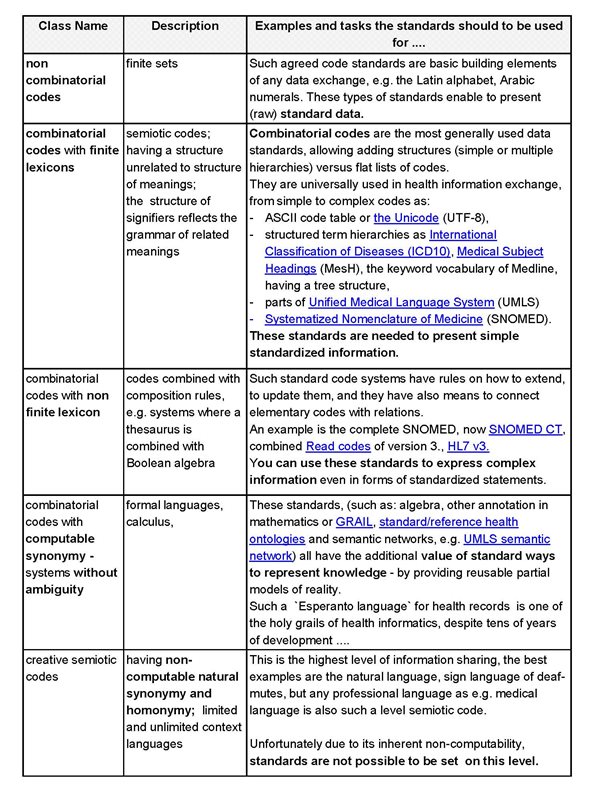Health Informatics Standards - Standard Content: Difference between revisions
Bosmana fem (talk | contribs) (Created page with " Category:Health Informatics Standards – general introduction") |
Bosmana fem (talk | contribs) mNo edit summary |
||
| Line 1: | Line 1: | ||
=Code Systems, Nomenclatures and Classifications= | |||
Health informatics Standards, in general, are discussed on the FEM WIKI page `Health Informatics Standards – general introduction`. Two other related pages focus on system/process standards and various other health informatics standards. This page focuses on standard content. The goal of standardizing content is to ensure interoperability and transparency on the semantic level of information exchange so that the meaning of data is understood unambiguously. It has to be noted that the need for unambiguous interpretation of health data preceded the current era of informatics. Therefore a lot of standard for content has a strong legacy and a long history. (A excellent example is the classification of diseases (some elements: first classification in Jean Fernel’s `Universa Medicini`, published in 1554, first internationally accepted (ISI) classification by Bertillon, 1893, listing fourteen major classes, already mixing groups denoted by their bodily location, by age, by cause <Ref>Details here: http://www.cdc.gov/nchs/data/misc/classification_diseases2011.pdf</ref>.) | |||
To achieve the above-stated goals, you find content standards in health informatics on different layers: data standards and metadata standards. To understand the deep, conceptual difference of these layers from a semiotic point of view, see the work of Gangemi et al. l <Ref>Gangemi, A., Galanti M., Galeazzi E., Rossi Mori, A.: Beyond UMLS: Computational Semantics for Medical Records in: Lun KC, et al eds., MEDINFO, 92, Amsterdam, Elsevier, 1992</ref>. Here is a simplified version helping us to understand which type of content standard on the data layer could be used for which type of tasks: | |||
[[File:0143.gangemi table for fem wiki.jpg-600x0.jpg|1000px|frameless|center]] | |||
Regarding the issue of how to implement/present this content, several content model (data model) standards are trying to establish transparent, reusable reference frameworks to publish this content data. The best-known archetype of a huge number of these kinds of standards is the family EN 13606-1..4:2007 Health informatics - Electronic health record communication standard. Please also take a look at the FemWiki entry 'Health Informatics Standards - Health Information Systems and Processes' for more details on these. On the metadata level currently, there is no widely used standard, however the general Dublin Core Metadata standard, DCMI (also an ISO standard), has many health applications. | |||
=Further reading:= | |||
<References/> | |||
==FEM PAGE CONTRIBUTORS 2007== | |||
; Contributor | |||
: Laszlo Balkanyi | |||
[[Category:Health Informatics Standards – general introduction]] | [[Category:Health Informatics Standards – general introduction]] | ||
Revision as of 15:01, 26 March 2023
Code Systems, Nomenclatures and Classifications
Health informatics Standards, in general, are discussed on the FEM WIKI page `Health Informatics Standards – general introduction`. Two other related pages focus on system/process standards and various other health informatics standards. This page focuses on standard content. The goal of standardizing content is to ensure interoperability and transparency on the semantic level of information exchange so that the meaning of data is understood unambiguously. It has to be noted that the need for unambiguous interpretation of health data preceded the current era of informatics. Therefore a lot of standard for content has a strong legacy and a long history. (A excellent example is the classification of diseases (some elements: first classification in Jean Fernel’s `Universa Medicini`, published in 1554, first internationally accepted (ISI) classification by Bertillon, 1893, listing fourteen major classes, already mixing groups denoted by their bodily location, by age, by cause [1].)
To achieve the above-stated goals, you find content standards in health informatics on different layers: data standards and metadata standards. To understand the deep, conceptual difference of these layers from a semiotic point of view, see the work of Gangemi et al. l [2]. Here is a simplified version helping us to understand which type of content standard on the data layer could be used for which type of tasks:
Regarding the issue of how to implement/present this content, several content model (data model) standards are trying to establish transparent, reusable reference frameworks to publish this content data. The best-known archetype of a huge number of these kinds of standards is the family EN 13606-1..4:2007 Health informatics - Electronic health record communication standard. Please also take a look at the FemWiki entry 'Health Informatics Standards - Health Information Systems and Processes' for more details on these. On the metadata level currently, there is no widely used standard, however the general Dublin Core Metadata standard, DCMI (also an ISO standard), has many health applications.
Further reading:
- ↑ Details here: http://www.cdc.gov/nchs/data/misc/classification_diseases2011.pdf
- ↑ Gangemi, A., Galanti M., Galeazzi E., Rossi Mori, A.: Beyond UMLS: Computational Semantics for Medical Records in: Lun KC, et al eds., MEDINFO, 92, Amsterdam, Elsevier, 1992
FEM PAGE CONTRIBUTORS 2007
- Contributor
- Laszlo Balkanyi
